Abstract
Investigations into the 0-group fish in the Barents Sea have been carried out since 1965, with the goal of estimating the abundance of 0-group fish. 0-group abundance indices have been used in the assessment of the recruitment level and in recruitment variability studies. However, the ecological importance of the 0-group fish in the Barents Sea has been less studied. Although 0-group capelin, herring, cod and haddock are widely distributed in the Barents Sea, the central area seems to be the most important, accounting for approximately 50–80% of the annual biomass. The total biomass of the four most abundant 0-group fish species can be up to 3.3 million tonnes, with an average of 1.3 million tonnes (1993–2009). Wide distribution and high biomass of pelagically distributed 0-group fish make these fishes an important element in the energy transport between different trophic levels and different geographical areas, having a critical impact on the entire Barents Sea ecosystem. In recent years, capelin have shown a pronounced northward shift in biomass distribution, and several successive strong year classes occurred during warm temperature conditions. Cod biomasses were unexpectedly low during warm years and were positively correlated with spawning stock biomass, while the correlation with temperature was not significant. Haddock and herring show, as expected, increasing biomass with increased temperature when the spawning stock is at a sufficiently high level.





Similar content being viewed by others
Abbreviations
- 0-group fish:
-
Fish in their first year of life when they are 5–7 months old in August–September
- SSB:
-
Spawning stock biomass
- AB:
-
Actual biomass
- EB:
-
Estimated biomass
- Kola T:
-
Temperature
References
Anonymous (1980) Preliminary report of the international 0-group fish survey in the Barents Sea and adjacent waters in August–September 1980. Annal Biol, Cons Int Explor Mer 37:259–266
Anonymous (2006) Survey report from the joint Norwegian/Russian ecosystem survey in the Barents Sea August-October 2006. IMR/PINRO Joint Report Series, No. 2/2006. ISSN 1502-8828, 97 pp
Anonymous (2007) Cruise report by Johansen GO, Torkelsen T, Alvarez J, Røttingen J, Tenningen M, Johansson TE and Skjold B. Methodology for assessment of the capelin spawning migration in the Barents Sea, spring 2007 (in Norwegian w/English summary). Cruise report, Institute of Marine Research, Bergen, Norway. Toktrapport/Havforskningsinstituttet/ISSN 1503‐6294/Nr.12—2007, pp 1–42
Anonymous (2008) Cruise report by Eriksen E, Johansen GO, Pedersen G, Peña H, Svellingen I, Seim S and Knag AC. Methodology for assessment of the capelin spawning migration in the Barents Sea, spring 2008. Cruise report, Institute of Marine Research, Bergen, Norway. Toktrapport/Havforskningsinstituttet/ISSN 1503‐6294/Nr.8—2008, pp 1–33
Anonymous (2009a) Cruise report by Eriksen E, Johansen GO, Tjelmeland S, Peña H and Alvarez J. Joint survey report Methodology for assessment of the capelin spawning migration in the Barents Sea, spring 2009. Cruise report/Toktrapport/Havforskningsinstituttet/ISSN 1503-6294/Nr. 1—2009, pp 1–27
Anonymous (2009b) Survey report from the joint Norwegian/Russian ecosystem survey in the Barents Sea August-October 2009. IMR/PINRO Joint Report Series 12/2009, ISSN 1503-6294, 120 pp
Barrett RT, Krasnov JV (1996) Recent responses to changes in stocks of prey species by seabirds breeding in the southern Barents Sea. ICES J Mar Sci 53:713–722
Bergstad OA, Jørgensen T, Dragesund O (1987) Life history and ecology of gadoid resources of the Barents Sea. Fish Res 5:119–161
Boitsov VD, Lebed NI, Ponomarenko VP, IYa Ponomarenko, Tereshchenko VV, Tretyak VL, Shevelev MS, Yaragina NA (1996) Formation of year classes and impact of environmental conditions. Dynamics of population size. In: Bochkov et al (eds) The Barents Sea Cod (biological and fisheries outline). PINRO Press, Murmansk, pp 157–199 (in Russian)
Dalpadado P, Bogstad B (2004) Diet of juvenile cod (age 0–2) in the Barents Sea in relation to food availability and cod growth. Polar Biol 27:140–154
Dalpadado P, Bogstad B, Gjøsæter H, Mehl S, Skjoldal HR (2002) Zooplankton-fish interactions in the Barents Sea. In: Sherman K, Skjoldal HR (eds) Large marine ecosystems of the North. Atlantic, Elsevier, pp 269–291
Dalpadado P, Bogstad B, Eriksen E, Rey L (2009) Distribution and diet of 0-group cod and haddock in the Barents Sea in relation to food availability. Polar Biol 32:1583–1596
Dingsør GE (2005) Estimating abundance indices from the international 0-group fish survey in the Barents Sea. Fish Res 72:205–218
Dingsør GE, Ciannelli L, Chan KS, Ottersen G, Stenseth NC (2007) Density dependence and density independence during the early life stages of four marine fish stocks. Ecology 88:625–634
Dragesund O, Hylen A, Olsen S, Nakken O (2008) The Barents Sea 0-group surveys; a new concept of pre-recruitment studies. In: Nakken O (ed) Norwegian spring-spawning herring and Northeast Arctic cod–100 Years of Research and Management. Tapir Academic Press, Trondheim, pp 119–136
Eriksen E, Prozorkevich DV, Dingsør GE (2009) An evaluation of 0-group abundance indices of the Barents Sea fish stocks. Open Fish Sci J 2:6–14
Fossheim M, Pedersen T (2008) Diet of 0-group stages of capelin (Mallotus villosus), herring (Clupea harengus) and cod (Gadus morhua) during spring and summer in the Barents Sea. Mar Biol 153:1037–1046
Gjøsæter H (1998) The population biology and exploitation of capelin (Mallotus villosus) in The Barents Sea. Sarsia 83:453–476
Gjøsæter H, Bogstad B (1998) Effects of the presence of herring (Clupea harengus) on the stock-recruitment relationship of Barents Sea capelin (Mallotus villosus). Fish Res 38:57–71
Godø OR, Valdemarsen JW, Engås A (1993) Comparison of efficiency of standard and experimental juvenile gadoid sampling trawls. ICES Mar Sci 196:196–201
Hallfredsson EH, Pedersen T (2007) Effects of predation from pelagic 0-group cod (Gadus morhua) on mortality rates of capelin (Mallotus villosus) larvae in the Barents Sea. Can J Fish Aquat Sci 64(12):1710–1722
Hallfredsson EH, Pedersen T (2009) Effects of predation from juvenile herring (Clupea harengus) on mortality rates of capelin (Mallotus villosus) larvae. Can J Fish Aquat Sci 66:1693–1706
Hamre J (1994) Biodiversity and exploitation of the main fish stocks in the Norwegian–Barents Sea ecosystem. Biodivers Conser 3:392–473
Hjermann DØ, Bogstad B, Dingsør GE, Gjøsæter H, Ottersen G, Eikeset AM, Stenseth NC (2010) Trophic interactions affecting a key ecosystem component: a multi-stage analysis of the recruitment of the Barents Sea capelin. Can J Fish Aquat Sci 67:1363–1375
Hussy K, Mosegaard H, Hinrichsen HH, Bottcher U (2003) Using otolith microstructure to analyse growth of juvenile Baltic cod Gadus morhua. Mar Ecol Prog Ser 258:233–241
Hylen A, Korsbrekke K, Nakken O, Ona E (1995) Comparison of the capture efficiency of 0-group fish in the pelagic trawls. In: Hylen A (ed) Precision and relevance of pre-recruit studies for fishery management related to fish stocks in the barents sea and adjacent waters, proceedings of the sixth IMR-PINRO symposium, Institute of Marine Research, Bergen, Norway, 1994, pp 145–156
Hylen A, Nakken O, Nedreaas K (2008) Northeast Arctic cod: fisheries, life history, fluctuations and management. In: Nakken O (ed) Norwegian spring-spawning herring and Northeast Arctic cod–100 Years of Research and Management. Tapir Academic Press, Trondheim, pp 83–118
ICES (2009) Report of the Working Group on Widely Distributed Stocks (WGWIDE), Copenhagen 2–8 Sept 2009, ICES CM 2009/ACOM:12, 563 pp
ICES (2010) Report of the Arctic Fisheries Working Group, Lisbon/Bergen, 22–28 April 2010, ICES CM 2010/ACOM:05, 664 pp
Loeng H, Gjøsæter H (1990) Growth of 0-group in relation to temperature conditions in the Barents Sea during the period 1965–1989. ICES CM 1990/G:49, 9 pp
Mamylov VS (2004) About the comparison of fish distribution densities estimated using trawl and acoustic methods. In: Chernook V (ed) Improvement of instrumental methods for stock assessment of marine organisms, Proceedings of the Russian-Norwegian Workshop, Murmansk 2003. PINRO Press, Murmansk, pp 114–132
Marshall CT, Kjesbu OS, Yaragina NA, Solemdal P, Ulltang Ø (1998) Is spawner biomass a sensitive measure of the reproductive and recruitment potential of Northeast Arctic cod? Can J Fish Aquat Sci 55:1766–1783
Marti YY (1956) Life cycle of Atlanto-Scandinavian herring. Trudy PINRO 9:5–61 (in Russian)
Orvik KA, Skagseth Ø, Mork M (2001) Atlantic inflow to the Nordic Seas: current structure and volume fluxes from moored current meters, VM-ADCP and SeaSoar-CTD observations, 1996–1999. Deep-Sea Res I 48:937–957
Ottersen G, Loeng H (2000) Covariability in early growth and year-class strength of Barents Sea cod, haddock, and herring: the environmental link. ICES J Mar Sci 57:339–348
Ottersen G, Sundby S (1995) Effects of temperature, wind and spawning stock biomass on recruitment of Arcto-Norwegian cod. Fish Oceanogr 4:278–292
Ozhigin VK, Tretyak VL, Yaragina NA, Ivshin VA (1999) Oceanographic conditions of the Barents Sea and their influence on the survival and development of young Northeast arctic cod. PINRO Press, Murmansk, p 88 (in Russian)
Ponomarenko IYa (1973) The influence of feeding and temperature conditions on survival of the Barents Sea “bottom” juvenile cod. Voprosy okeanografii severnogo promyslovogo basseina: Selected papers of PINRO. Murmansk 34:210–222 (in Russian)
Sætersdal G, Loeng H (1987) Ecological adaptation of reproduction in Northeast Arctic cod. Fish Res 5:253–270
Skaug HJ, Gjøsæter H, Haug T, Nilssen KT, Lindstrøm U (1997) Do minke whales (Balaenoptera acutorostrata) exhibit particular prey preferences? J Northw Atl Fish Sci 22:91–104
Sonina MA (1969) Biology of the Arcto-Norwegian haddock during 1927–1965. Fisheries Research Board of Canada Translation Series, No. 1924, 151 pp
Sundby S, Nakken O (2008) Spatial shifts in spawning habitats of Arcto-Norwegian cod related to multidecadal climate oscillations and climate change. ICES J Mar Sci 65:953–962
Tereshchenko VV (1996) Seasonal and year-to-year variations of temperature and salinity along the Kola meridian transect. ICES CM 1996/C:11, 24 pp
Toresen R, Gjøsæter H, Barros PC (1998) The acoustic method as used in the abundance estimation of capelin (Mallotus villosus Müller) and herring (Clupea harengus Linné) in the Barents Sea. Fish Res 34:27–37
Acknowledgments
We thank Natalia Yaragina, an anonymous referee and the editor for their constructive comments which greatly improved the quality of the paper. We also thank Daniel Howell for providing language improvements. We would like to acknowledge economic support provided by the Barents Sea Research program at IMR and from the EU project FACTS.
Author information
Authors and Affiliations
Corresponding author
Rights and permissions
About this article
Cite this article
Eriksen, E., Bogstad, B. & Nakken, O. Ecological significance of 0-group fish in the Barents Sea ecosystem. Polar Biol 34, 647–657 (2011). https://doi.org/10.1007/s00300-010-0920-y
Received:
Revised:
Accepted:
Published:
Issue Date:
DOI: https://doi.org/10.1007/s00300-010-0920-y




